
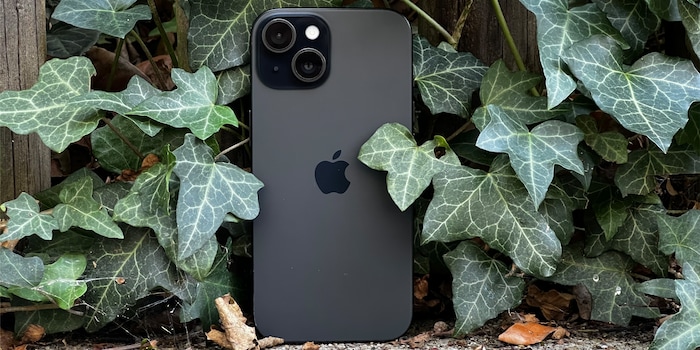
iPhone 15: old wine in new bottles or a serious Pro alternative?
The Apple world, including the manufacturer itself, is almost exclusively talking about the new iPhone Pros. Weird then, that the iPhone 15 is actually the better choice for most Apple users. I’ll tell you why here.
While the Pro models bring great innovations year after year, the basic 12, 13 and 14 iPhones were simply boring. A few more milliamp hours in the battery, new Bluetooth – that’s it. Apple didn’t even update the processor in the 14.

Things have changed this year. Surging past the Pro, Pro Max and Plus, the basic model is the secret star. Apple has put in a lot of effort. It’s obvious when I compare: almost everywhere, the iPhone 15 can compete with the 6.1-inch Pro – and it’s much cheaper. So you should prefer it.
Pick it up – and never let it go again
One aspect that is often underestimated in smartphones is haptics. One study by the University of Bonn found that we pick up our mobile phones an average of 88 times a day. With that many grabs, it’s incredibly important to actually like how your device feels. Apple probably thought the same: the Californians have moved on from the glossy back and a reflective frame and replaced both with a matt surface. When I touched it for the first time, I initially thought that Apple had skipped glass completely.
But worry not, this isn’t the case. Instead, the glass is now brushed – ergo the matt effect. Apple has also made the iPhone 15 slimmer, about half a millimetre narrower than the iPhone 15 Pro. Sounds like nothing. But combined with the slightly rounded edges, this can be quite noticeable for people with small hands – like me. The difference in weight compared to the Pro model is also striking. Despite the Pro model’s lightweight titanium frame, it’s 16 grammes heavier. 187 instead of 171 grammes, to be precise. As a result, I prefer the iPhone 15 in terms of feel and weight.
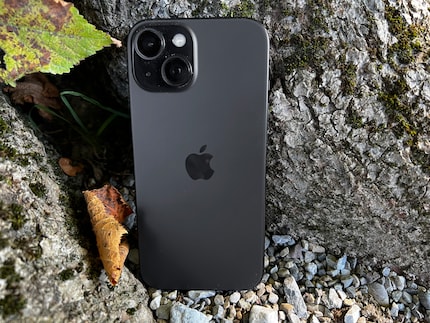
Source: Florian Bodoky
Visually, there are no major changes beyond that. The haptics make all the difference. Overall, I like holding the iPhone 15 so much that I – like my colleague Samuel – decided to use the phone without a case for a while.
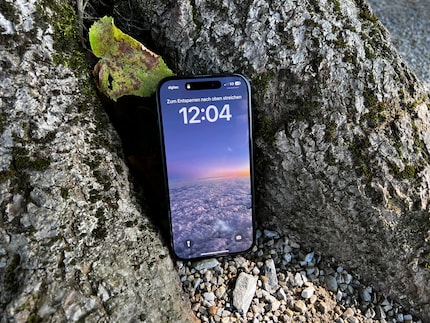
Source: Florian Bodoky
After a week of this, I end up with one pro and one con. Pro: the matt back is less susceptible to fingerprints than the glossy devices of years past, if not completely immune. Cons: both devices are way more slippery. After two drops, a cover is quickly thrown on. I forgo that strangely satisfying feeling of brushed glass in my hand. Or that snazzy slide into my pockets. The case isn’t nearly as pleasant. But this way, I avoid the near-physical pain whenever the device slips out of my hand. By the way, my case is made of good old silicone – negative feedback on the Fine Woven cases have kept me from trying them.
Pure ambivalence: the screen
The screens on the iPhone 15 and the Pro variant are very similar. Both sport a Super Retina XDR OLED display. As with the predecessors over the last few years, you get a screen diagonal of 6.1 inches, or around 15.5 centimetres, resulting in an aspect ratio of 19.5:9. The resolution is 1179 × 2556 pixels. That isn’t only far from 4K, but also the same resolution as the iPhone 14 Pro. Same for pixel density, 461 ppi. The screen-to-body ratio improves minimally to 88.2 per cent compared to 86.4 per cent in the iPhone 15. So far, so unspectacular.
However, the display looks very sharp in real life. The colours stand out nicely, but aren’t unnaturally bright or gaudy. In addition, Apple includes True Tone technology like every year. This ensures that the display brightness and colour intensity adapt to your environment. One advantage here is that your iPhone battery lasts longer than always having the screen at maximum brightness.
This brings us to the signature change, the display improvement: the iPhone 15 display offers 2,000 nits at peak brightness (same as the Pro). That deserves further exploration. I make my own light diffuser out of paper and get to work with the luxmeter. This won’t give foolproof lab results. But I can tell if Apple is lying to you with its specs.
The app is American, and consequently states its results in «candela per square foot». I repeat the test a total of three times in direct sunlight, ending up with 170 candela per square foot. This corresponds to approximately 1,830 nits. Even if it’s only an approximation due to the test scenario, this is a strong value. You won’t have any problems recognising display contents – even in strong sunlight.
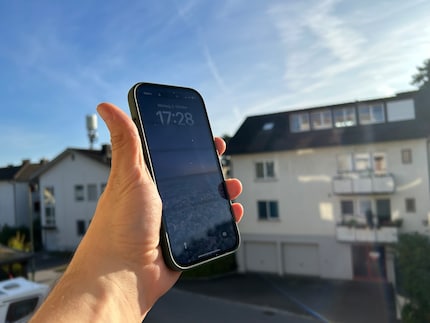
Source: Florian Bodoky
So the display of the iPhone 15 can actually do everything that the Pro version can? Not quite, there is one downer. Apple only offers a refresh rate of 60 hertz. The Pro model, as well as Android devices, have long offered frame rates of 120 hertz – especially in the iPhone’s price range. Even some entry-level models from the Android world offer at least 90 hertz.
This is noticeable in a short comparison with the Pro version. Scrolling through individual app screens or menus runs a bit smoother and faster. However, this is extreme nitpicking: the iPhone 15 responds very quickly and I don’t detect streaks or delays when scrolling. In short, the frame rate doesn’t become an annoyance for me in everyday use.
Performance
It’s always debatable how much significance benchmarks have in everyday use. Especially if you just want to use the device as a smartphone and aren’t interested in gaming features and the like. However, performance is relevant here insofar as the iPhone can connect to many external devices via USB-C. Displays and game controllers included.
This is because unlike the Pro model, the iPhone 15 doesn’t yet come with the new Bionic A17 processor, manufactured in the 3-nanometre process. Instead, it sports the Bionic A16, the in-house CPU of the iPhone 14 Pro. You also have to make do with six gigabytes of RAM.
I test the performance of the CPU and GPU with AnTuTu Benchmark 6. As you can see, the results are all about where you’d expect them to be. Namely, on par with last year’s Pro model, the iPhone 14 Pro – but clearly above its predecessor, the iPhone 14. How is this reflected in everyday life? Is the device suitable for gaming? Yes, as you’ll be able to read in more detail.
USB-C: one port for everything. And I mean everything
When the EU Parliament adopted the proposal for a uniform charging cable,
I couldn’t help feeling a certain amount of schadenfreude. I’ve always been annoyed by the proprietary Lightning port.
But after testing, I have to take my hat off to Apple. Instead of simply adding a USB-C port with a charging function (or even leaving Lightning and including an adapter), Apple has made an effort. Thanks to USB-C, the device fits perfectly into your equipment, even if you’re outside the Apple-verse. Besides the obvious advantage of only needing one charging cable, Apple offers some additional features. Here’s a sampling of the best:
Connecting external memory
You can connect an external storage medium. This will then be displayed in the iPhone’s Files app as a regular storage location. The cool thing: it fully worked with all external storage media I tested. Even my old external HDD from 2013 (!) with a USB-A to USB-C adapter or the giveaway Billo memory stick didn’t cause me any problems.
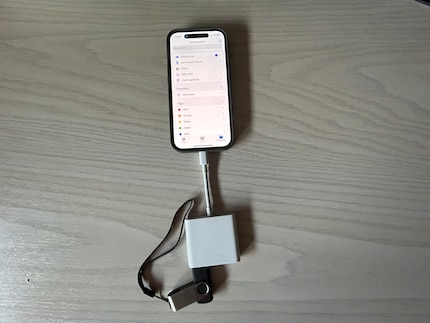
Source: Florian Bodoky
Reserved for the Pro, however, is the ability to directly set external storage media as the storage location for video recordings. The reason? Data throughput in the basic iPhone 15 is pretty meagre at 480 Mbps. This corresponds to the USB 2.0 standard. Not that this really matters for the odd document or photo.
The iPhone as a mobile office
The USB-C port also makes it easy to connect the iPhone to external devices such as screens, keyboards and even mice. The iPhone, a mobile office.
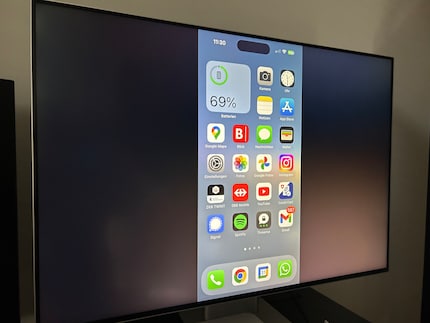
Source: Florian Bodoky
In my test, none of the connected devices were Apple brand. I used a Huawei monitor, a Keychron keyboard, a Logitech mouse and a Satechi dock.
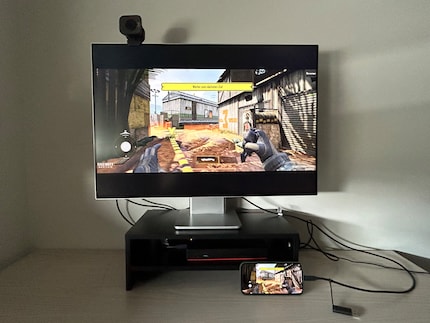
Source: Florian Bodoky
Not an issue whatsoever. I was able to take notes, surf and use other apps without any problems. Even in landscape mode: when you rotate the iPhone, the same happens on the external screen. This way you can watch Netflix or YouTube videos in full-screen.
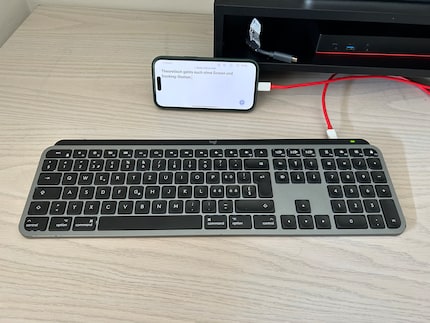
Source: Florian Bodoky
In principle, the devices also work without a dock. In my test, I connected the iPhone 15 directly to the screen and navigated via the touch controls. If the mouse and keyboard are now connected via Bluetooth (works with MX Keys, for example), you can use the iPhone as a makeshift laptop replacement.
Problem-free gaming on an iPhone
Despite its 60-hertz refresh rate, the phone is also suitable for gaming. You can choose whether you want to use the iPhone itself or an external unit as the controller. For example, you can connect the iPhone 15 to the PlayStation 5 DualSense controller without any problems – this also works via Bluetooth.
I try a round of Call of Duty: Mobile. The graphically quite demanding game runs smoothly on the screen overall. I encounter very few freezes that give me a disadvantage or spoil the fun of the game. Quite the contrary, in fact.
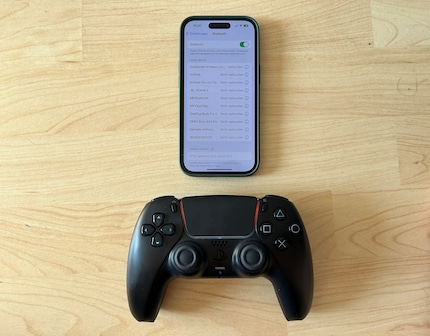
Source: Florian Bodoky
Accordingly, I am surprised by the fluidity and fun of the game. Only, after about 45 minutes, the heat development of the iPhone worries me a bit. The performance doesn’t drop and the device doesn’t switch to power-save mode. Nevertheless, it isn’t built for extended gaming nights with external equipment, but more for casual gaming while commuting. This is working well so far, but I don’t particularly like the touch screen controls.
A charger for other devices
This has been commonplace for a while in the Android universe. Another reason why I’m glad USB-C has found its way onto the iPhone. The iPhone 15 can provide other devices with some juice for everyday use. Whether USB-C to USB-C or USB-C to Lightning, you can connect two devices and the iPhone 15 will increase the runtime for its counterpart. If you connect two iPhone 15s with each other, the one with the lower battery level will be charged.
Camera: now the differences show
The Pro series differs most clearly from the iPhone 15 in terms of the camera. You’re still greeted by two diagonal lenses here. Apple includes a macro camera in its base model. And the ultra-wide angle has hardly changed either.
Main camera: 48 megapixels and near 2x optical zoom
The main camera now sports up to 48 megapixels, like the Pro model. A significant step in itself: the iPhone 14 has a 12 MP main camera without optical zoom. But beware: despite sharing resolutions with the Pro model, this isn’t the same lens. On the Pro, the focal length is at least digitally variable (24, 28 and 35 mm), on the regular model it’s a fixed 26 mm. In exchange, the ƒ/1.6 aperture is slightly larger (the Pro has ƒ/1.78). You also have to do without the triple zoom of the Pro.
The main camera takes 24-megapixel pictures by default. If this isn’t enough, you can change the default resolution. The full 48 megapixels are also available in the camera settings, which are then saved in Apple’s own HEIF format. You have to keep in mind that the file size will increase a lot. Of course, the result does better in post-processing up to a certain point. However, based on my sample shots, I think the difference in detail is negligible – but the file size is twice as large.
In general, the infamous oversharpening has lessened a bit and the post-shot HDR algorithm brightens pictures slightly. Colours look rich, but don’t drift into the absurd. All in all, very pleasing results.

Source: Florian Bodoky
Apple limits itself to a 12 MP resolution for dual-zoom shots. As a result, some details are lost, especially in poor lighting conditions. However, this is kept within limits.
Portrait mode has had its day
One of the coolest innovations in the camera sector is automatic facial recognition (including animals). You no longer need to switch to Portrait mode. As soon as the iPhone recognises a face or you set a focus, a small «F» appears in the lower right corner.
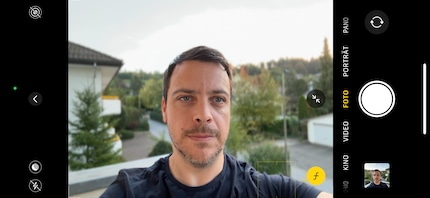
Source: Florian Bodoky
When you tap on it, the algorithm adds depth of field. This way you can bring people or animals into better focus. The coolest thing: you can change the depth of field to your liking when you edit the image later. This makes creating portrait shots much easier. Especially if you aren’t so familiar with the camera and its modes.
Beyond the main camera and portrait recognition, however, little has changed. The ultra-wide-angle camera remains the same as in the iPhone 14. 12 megapixels and an angle of 120 degrees.
Essentially, the wide angle is there to capture just that – wide-angle subjects, such as in group photos. Something you’d want to put on Instagram or send to friends via WhatsApp. That’s a little disappointing.
Battery: runs long – charges slowly
A capacity of 3,349 milliampere hours at first sounds ridiculous for a smartphone in this price range. Even more so in 2023. However, Apple adapts its software accordingly and promises energy efficiency. I do my everyday test and measure the runtime with System Status Pro: hw Monitor. The iPhone 15 has been my main phone for a good two weeks. I talk on the phone for an average of 15 to 20 minutes a day in stages, stream Spotify music for about two hours a day, watch 15 minutes of videos/reels on YouTube and Insta and write twenty WhatsApp messages. The camera is used for four to five snapshots per day.
After ten measurements (over ten days), the battery life averages around eleven hours. It doesn’t need a 5000-mAh monster for a satisfying battery runtime. If you compare this value with reviews online, the iPhone 15 also beats its big Pro brother. That one dies after less than ten hours.
While I’m quite happy with this performance, the charging speed annoys me. 30 to 35 minutes for half a battery charge and 27 watts maximum charging speed mean I have to plug in the phone every night despite its solid battery.
Verdict: only photo/video freaks should get the Pro
I was surprised how much work Apple put into the iPhone 15. Its stepmotherly existence in recent years is a thing of the past. Yes, I’d have liked a 120-hertz display and ProMotion. Otherwise, the device is on par with the iPhone 15 Pro. It also shares the same application scenarios for the USB-C port. The battery even lasts longer. The charging speed is no longer up to date, regardless of the model. As a result, the only notable differences, in my opinion, are in photography and video. Including the option to define external SSDs as standard storage for large volumes of data, which primarily benefits ProRes videos.
So, here’s the bottom line: if you’re not after the latest camera features, save a few hundred francs and go for the basic iPhone 15 model. And if you do happen to be a camera enthusiast, you should make the jump to the iPhone 15 Pro Max right away anyway.
Header image: Florian Bodoky
I've been tinkering with digital networks ever since I found out how to activate both telephone channels on the ISDN card for greater bandwidth. As for the analogue variety, I've been doing that since I learned to talk. Though Winterthur is my adoptive home city, my heart still bleeds red and blue.



